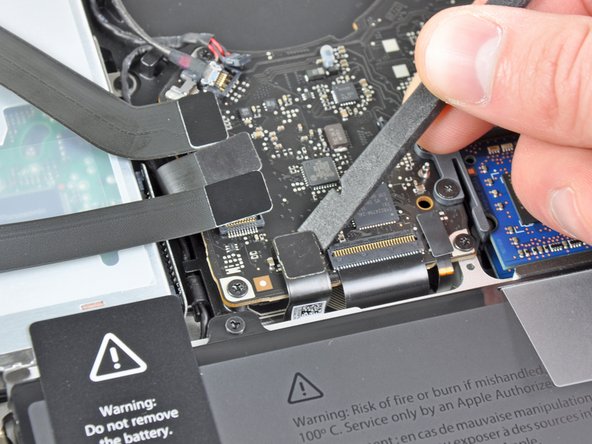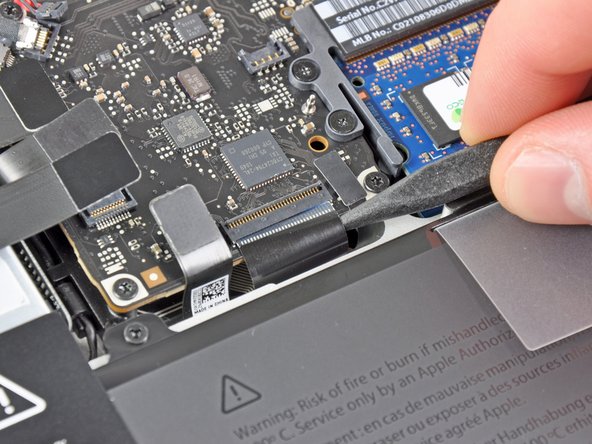MacBook Pro 13″ Unibody Late 2011 Microphone Replacement
Duration: 45 minutes
Steps: 23 Steps
Hey there! Just a little reminder: tackling repairs can be tricky, so take your time and don’t hesitate to ask for help if you need it. If you’re feeling stuck, you can always schedule a repair. You’ve got this!
Ready to tackle that pesky broken microphone? Dive into this guide and let’s get that sound back on track! If you need help, you can always schedule a repair.
Step 1
– Unscrew those ten little screws like a pro!
Step 2
– Gently use your fingers to lift the lower case away from the MacBook’s body, starting near the vent. It’s like giving your MacBook a little hug!
– Now, go ahead and take off the lower case completely. You’ve got this!
Step 3
Gently nudge those short sides of the connector upwards to help it ease out of its snug little home. Just a heads-up: watch out for those corners; they’re a bit delicate and can break off if you’re not careful.
– Gently slide the edge of a spudger under the battery connector and lift it up from its snug home on the logic board. You’ve got this!
Tools Used
Step 4
– Gently nudge the battery cable away from its cozy spot on the logic board to avoid any accidental reconnections while you work your magic.
Step 5
Check out the second and third pictures to spot the fan socket and the fan connector. Be gentle while using your spudger to lift the fan connector straight up and out of its socket—nobody wants to break that delicate plastic fan socket off the logic board! The layout of your logic board might look a bit different from what you see in the second picture, but don’t worry, the fan socket is still the same.
A little twist of the spudger from below the fan cable wires can do wonders to free up that connector. You’ve got this!
– Gently use the spudger’s edge to nudge that fan connector up and out of its cozy little home on the logic board.
Tools Used
Step 6
– Unscrew those three little screws that are holding the fan snugly to the logic board. You’ve got this!
Step 7
– Gently lift the fan out of its cozy spot on the logic board, being careful of its cable that might want to tag along.
Step 8
– Grab your trusty spudger and gently wiggle the tip under the right speaker/subwoofer cable, coaxing it out from beneath the snug little retaining finger molded into the upper case.
– With a steady hand, lift that right speaker/subwoofer cable upwards to free the connector from its cozy home on the logic board.
Tools Used
Step 9
– Unplug the camera cable from the logic board with care.
Step 10
To unplug those cables, grab the flat end of a spudger and gently lift their connectors up from the sockets on the logic board. You’ve got this!
– Unplug these four cables and let’s keep things running smoothly!
Tools Used
Step 11
Make sure you’re gently lifting the hinged retaining flap and not the socket itself. You’ve got this!
– Use your fingernail to gently lift the retaining flap on the keyboard ribbon cable ZIF socket. You’ve got this!
– Grab your trusty spudger and use its tip to carefully pull the keyboard ribbon cable out of its socket. Easy peasy!
– If the cable is being a little stubborn, no worries! Just attach a piece of tape to the cable temporarily to help guide it into the socket smoothly.
Tools Used
Step 12
– If there’s a little black tape hanging out, go ahead and peel it off to reveal the keyboard backlight cable socket. You’ve got this!
Step 13
Make sure you’re gently lifting the hinged retaining flap and not the socket itself. You’ve got this!
– Grab the tip of a spudger or your trusty fingernail and gently lift up the retaining flap on that keyboard backlight ribbon cable ZIF socket.
– Now, give that keyboard backlight ribbon cable a little tug to pull it out of its cozy socket.
Tools Used
Step 14
– Gently use the flat end of a spudger to lift the sleep sensor/battery indicator connector out of its cozy spot on the logic board.
Tools Used
Step 15
Hey there! Just a quick heads-up: be gentle with the display data cable! It’s a bit delicate, so instead of lifting it up, make sure to pull it straight out, parallel to the logic board. You’ve got this!
– Take hold of that handy plastic pull tab connected to the display data cable lock and give it a twist towards the DC-In side of your device.
– Gently pull the display data cable straight out from its cozy spot on the logic board.
Step 16
For some models, you might notice that the screws are a tad shorter, and that’s perfectly normal!
– Unscrew those nine little screws and set them aside like the pros do!
Step 17
– Let’s kick things off by unscrewing those two little screws right there!
– Next up, gently take out the display data cable retainer from the upper case. You’re doing great!
Step 18
– Grab your trusty spudger and gently coax the microphone away from the adhesive that’s holding it snugly to the upper case. Easy does it!
Tools Used
Step 19
– Carefully lift the logic board from the side closest to the optical drive, being mindful of the many connectors along the edges.
– Gently maneuver the board out of the upper case without bending it, keeping an eye on the flexible connection to the DC-In board that might get snagged.
– And there you have it, the logic board is free!
Step 20
– Gently guide the microphone cable out of the groove that’s shaped right into the left speaker housing. You’ve got this!
Step 21
– Peel off the tiny bit of black tape that’s hiding the microphone connector. You’ve got this!
Step 22
Gently lift from underneath those wires, and let the magic happen!
– Gently use the flat end of a spudger to lift the microphone connector out of its cozy spot on the logic board. You’ve got this!
Tools Used
Step 23
– Gently detach the microphone from the logic board. You’ve got this!





































